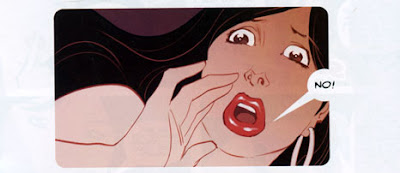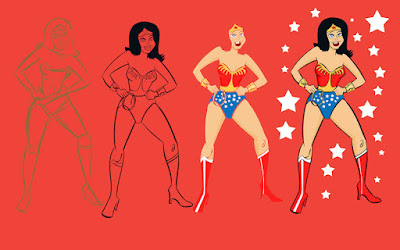Some random thoughts on
The Salon, which I enjoyed very much since its original webcomic incarnation. The post is a bit pedantic.

1) There is a clever conceit in
The Salon for fine-art lovers to latch onto: That the experiments of the painters
Georges Braque and
Pablo Picasso are linked to the story's magical blue
absinthe. There is an aesthetic contrast:
Cubism is the first
modern art movement to unambiguously reject the traditional notion that a painting is a metaphorical window into a world created by the artist using perspective techniques to produce the illusion of 3D space when seen from a single point of view. But the cubist depicts an object from multiple points of view, breaking-up and reassembling the object so that foreground, middle-ground, and background all coexist at the same depth, denying painting's illusory power. On the other hand, the blue absinthe that the main characters imbibe affirms that power by allowing them to literally step into the world of the painting being viewed. It's a fantastical notion similar to ideas used in children's literature and science fiction, and it's the kind of premise that comics were made to exploit. Fortunately
Nick Bertozzi is up to the challenge. He doesn't actually establish a definite causal relationship between Cubism and the absinthe: Braque and Picasso's creativity are not particularly motivated by the absinthe. Nor do they emphatically reject it. Where he succeeds is in visually blending all the elements: He is equally adept at conveying both fantastical and abstract environments, as well as the more down to earth squalor of early twentieth century
Montmartre. And he skillfully quotes from artists as diverse as
Paul Gauguin to Picasso.

2) As the story progresses, the historically based elements play a more prominent role, particularly the Braque-Picasso and Gertrude-Leo-Alice relationships. Nevertheless the fantastical murder mystery frames the entire story and serves as a mcguffin that informs the characters motivations and behavior. But Bertozzi still conforms to the broad outlines of his cast's real world histories. For example, Braque and Picasso's artistic collaboration is transformed into a heroic team-up. While
Leo Stein's disapproval of the romance between
Gertrude Stein and
Alice B. Toklas is reinterpreted as cowardly and traitorous.
Guillaume Apollonaire and
Erik Satie are regulated to sidekick status. This is obviously not historically accurate. But the urgency arising from the mystery gives The Salon a manic energy that wouldn't be found in a more straightforward biography. The comic never finds a perfect balance between fantasy and history, and in the end the former becomes an afterthought as the story becomes more character driven.

3) An ongoing comic-related, and
postmodern concern, is the undermining of the traditional hierarchy between high and low culture. This is most clearly and self-servingly attempted in causally connecting a
Katzenjammer Kids strip as partial inspiration to a famous proto-Cubist Gertrude Stein
portrait. But a more common technique is to lay bare the relationship between sexuality and fine-art: From
Eadweard Muybridge's controversial nude photo-sequences (A kind of proto-comic), to Gauguin's nubile Tahitian girls, to art dealers selling erotic pictures on the side. Art serves to express and satiate sexual impulses. Mostly male impulses. If possible, wouldn't some people fuck a painted nude made real? This high/low blurring is embodied in Picasso. His "heroic" persona is linked to his tempestuous romances, his sexual peccadilloes, his love for cartoon art, his openness to the intellectual arguments of Braque, his own natural talent, curiosity, and obsessive attention to detail.

4) In contrast to the many pages devoted to formal Cubist theory, the influence of
Primitivism on modern art receives little attention. There's a throwaway line of Picasso using African masks on his
nudes, something Picasso actually denied. But Picasso was influenced by Gauguin's Tahitian nudes. Back then (And now) the art of so-called primitive cultures was seen as flat, geometric, abstract, symbolic, and possessing exaggerated proportions - qualities considered admirable in modern art. Primitive cultures were characterized as being more natural and sexually free. Gauguin is said to have described Tahiti as an earthly
Arcadia. Most present day critics would consider those views as naive and distorted. The murderer is eventually revealed to be frankenstein-style recreation of Gauguin's Tahitian teenage mistress made from mixing paint and the blue absinthe: A dark mirror of Gauguin's passive figures. Bertozzi's critique of Gauguin's Primitivism isn't as extensive or thought-out as his examination of proto-Cubism. But Gauguin is nonetheless a larger than life figure here. So it's fitting that the thing that stops his monster is something created by Picasso, the heroic figure who has learned from the example of the master.

 But the art suggests that the story is meant to be read by at least older kids: While Thompson is clearly capable of rendering characters in a far more mawkish style, she applies restraint to the anthropomorphizing of the cast so that they still mostly look and behave like normal animals. Thus the violence is also less cartoony and has real consequences. Dorkin and Thompson make a concession to the narrative convention of using the animal's breed as a shortcut to underlining or contradicting the individual's personality: The Pug is pugnacious, the Jack Russell Terrier is excitable, and the Doberman looks mean but is actually a big coward. If this was a movie made today, the animals would be enhanced or rendered entirely in creepy looking CGI, while voiced by highly paid actors (Like here). So I count it as a good thing that the reader has only the comic art as a reference for now.
But the art suggests that the story is meant to be read by at least older kids: While Thompson is clearly capable of rendering characters in a far more mawkish style, she applies restraint to the anthropomorphizing of the cast so that they still mostly look and behave like normal animals. Thus the violence is also less cartoony and has real consequences. Dorkin and Thompson make a concession to the narrative convention of using the animal's breed as a shortcut to underlining or contradicting the individual's personality: The Pug is pugnacious, the Jack Russell Terrier is excitable, and the Doberman looks mean but is actually a big coward. If this was a movie made today, the animals would be enhanced or rendered entirely in creepy looking CGI, while voiced by highly paid actors (Like here). So I count it as a good thing that the reader has only the comic art as a reference for now. Issue #1 is somewhat hindered by the need to reestablish the characters. While there is an attempt to minimize the info dump, the dialogue is sometimes hampered by the regular referencing of past events. The supernatural threat that eventually reveals itself is visually impressive, but seems to be mainly there to demonstrate the demon fighting credentials of the Scooby Gang.
Issue #1 is somewhat hindered by the need to reestablish the characters. While there is an attempt to minimize the info dump, the dialogue is sometimes hampered by the regular referencing of past events. The supernatural threat that eventually reveals itself is visually impressive, but seems to be mainly there to demonstrate the demon fighting credentials of the Scooby Gang. In Issue #2, the gang has been shouldering more responsibility in protecting Burden Hill. But the series then veers unexpectedly into far more ambiguous territory when the threat turns out to be internal in origin and too mundane for their supernatural training to handle. And the ending is the most shocking so far delivered by the comic.
In Issue #2, the gang has been shouldering more responsibility in protecting Burden Hill. But the series then veers unexpectedly into far more ambiguous territory when the threat turns out to be internal in origin and too mundane for their supernatural training to handle. And the ending is the most shocking so far delivered by the comic.












































